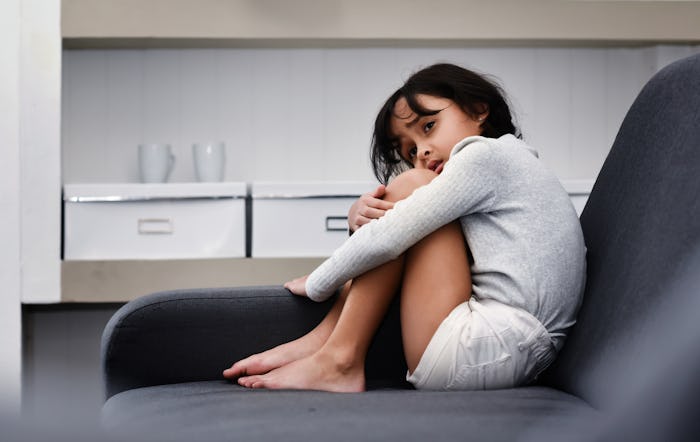Life

The Red Flags To Look Out For In Your Child's Anxious Behavior, According To Science
True story: I have generalized anxiety disorder. According to my therapist, I've probably had it all my life, but wasn't treated for it until my 20s. Because of this, I worry my kids will also develop problems with anxiety and I find myself looking for signs I might be missing. But when is your child's anxious behavior a red flag, and when is it just everyday anxiety?
Anxiety is not something anyone wants to deal with, and you especially hate to see your children dealing with its effects. It can be a debilitating condition that not only affects the mind, but is profoundly deleterious to the physical body as well. How can you recognize serious anxiety in a child? Kids are curious and often frightened creatures. There are monsters in the closet, the drain in the tub is especially terrifying, and if you have the wrong backpack for school, you might as well throw out the whole year, because it's ruined.
It's not always so simple, though. According to the American Academy of Pediatrics (AAP), children suffer from anxiety disorders at roughly the same rate as adults. The AAP defined anxiety disorders as occurring "when fears, worries, or anxiety occur outside the range of normal developmental responses or are extreme and cause significant distress or impairment in functioning (school, home, social settings)."
According to The Summit Counseling Center, there are a few things to look for when you find yourself wondering if your child's anxious behavior is a red flag. The first is to look at whether or not the distress matches the situation. Is their level of upset way out of proportion to the issue? Are they acting out more severely than appropriate?
Are they manifesting perfectionist behaviors outside of what is normal for them? Perhaps they're controlling what they eat, or ignoring issues entirely because there's no way they can be perfect? Are they worried almost all of the time, or at least significantly more than not? Often, according to the website for psychologist Dr. Kristi Wolfe, this is one of the first things parents notice, and it's definitely a red flag.
How are they sleeping? Do they feel OK? As I mentioned earlier, anxiety effects the whole body, chief among them their sleep and their health. I've been an insomniac since I was 8 or 9 years old, and it continues in my 30s. It causes me plenty of digestive upset and headaches, and this is the same for children, according to the AAP.
"What if?" "But if . . ." "How can I?" Repetitive questions like these are a red flag for anxiety disorders, too, according to Worry Wise Kids. It signals that your kids are worrying well in advance of whatever is going to or might happen, whether or not they will have any control over it, and that's a major red flag.
Does your child constantly need reassurance, or are they excessively people pleasing? While it may seem like something every kid does, it's not really a focus of most children to engage in people pleasing behavior, Wolfe added to her website.
But the biggest red flag for anxiety in children, according to the Clinical Psychology Review, is avoidance. If your child is going out of their way to avoid situations and people where they might experience new things or uncomfortable things, this is a serious red flag. Trepidation is one thing, but kids with anxiety may act out or become disruptive or sick to avoid the situation entirely.
If you're worried that your child might be more than just run-of-the-mill anxious, talk to your provider, and get help. I wish I'd gotten help years before I had; I think it could've made things so much better for me. You know your child. Your worries are valid, and you should talk to an expert to get the help your child needs.